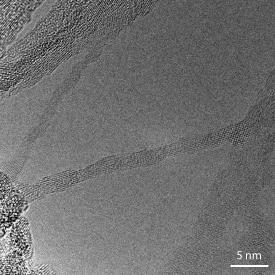

06/29/2015

Adapted with permission from Ref. 1. Copyright 2015 American Chemical Society.
A new way of producing sodium titanate nanowires for decontaminating radiation-tainted water has been developed by AIMR researchers1.
The meltdown of three reactors at the Fukushima Daiichi nuclear power plant in Japan following the tsunami in 2011 generated vast amounts of radioactively contaminated water ― over 600,000 metric tons according to a 2014 estimate by the Japanese government. To prevent this water from contaminating the environment, it is vital to develop materials capable of both trapping radioactive species and storing them safely.
One-dimensional sodium titanate nanostructures are attractive for this purpose because their sodium ions can be readily swapped for radioactive ions such as strontium.
Various methods for fabricating one-dimensional titanium oxide nanostructures have been developed. “However, most methods involve heating, which limits the properties of the nanostructures, including their crystallinity and shape,” explains Naoki Asao, who led the study. “In contrast, our method proceeds under non-thermal conditions, allowing ultrafine structures to form.”
Asao, Koji Nakayama and their colleagues at the AIMR at Tohoku University took a method usually used to produce nanoporous gold and applied it to ribbons of a titanium–aluminum alloy: they treated the ribbons at room temperature in aqueous sodium hydroxide and then centrifuged or decanted the resulting solution to obtain sodium titanate nanowires (see image).
The nanowires were produced by the simultaneous leaching of aluminum from the alloy and oxidation of titanium. This is the first time that ultrafine sodium titanate nanowires have been produced by this process.
X-ray diffraction and transmission electron microscopy revealed that the nanowires had a layered atomic structure in which layers of sodium ions were sandwiched between layers of TiO6 octahedrons.
“Because such layered structures can give rise to effective adsorbents, this result strongly encouraged us to study the nanowire’s ion-exchange properties with a view to decontamination at Fukushima,” says Asao.
The researchers discovered that the nanowires exhibited a remarkably high strontium ion exchange capacity and a very rapid uptake rate.
Furthermore, the nanowires selectively absorbed strontium ions. “The radiation-tainted water contains not only radioactive ions but also various nontoxic ions,” notes Asao. “This necessitates selective ion exchange. Our material is promising because it selectively captures strontium ions even when there are high concentrations of sodium ions.”
While the ultrafine nanowires show great potential, further research is necessary before they can be deployed in decontamination efforts, both at Fukushima and other clean-up sites. The team intends to improve the fabrication method to boost the selective capturing ability of the nanowires.
Ishikawa, Y., Tsukimoto, S., Nakayama, K. S. & Asao, N. Ultrafine sodium titanate nanowires with extraordinary Sr ion-exchange properties. Nano Letters 15, 2980–2984 (2015). | article
This research highlight has been approved by the authors of the original article and all information and data contained within has been provided by said authors.